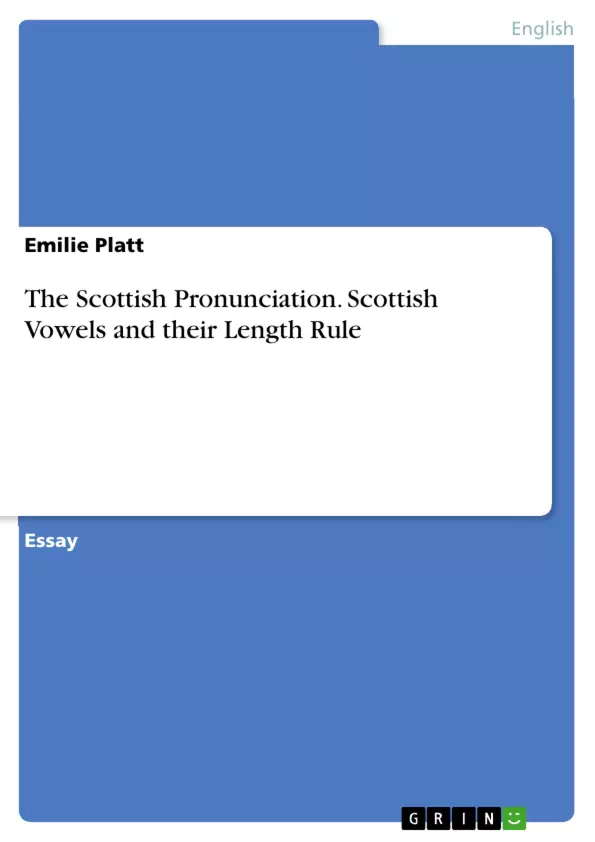The English language is widely spread. More than 20 countries all over the world consider English as their main and National language. However, all of these countries have their own accent which is quite interesting from a phonological point of view. On the one hand we have the consonantal system which does not seem to change very much within the different accents. On the other hand there is the vowel system which shows the exact opposite. The accent of the Scottish speaking population shall be in the main focus of this paper.
Table of Contents
- The English language is widely spread
- Aitken's Scottish Vowel Length Rule
- Early Scot High Short Vowels
- Early Scot Diphthongs
- Long Monophthongs
- Heinz J. Giegerich's Introduction in English Phonology
- Tamara V. Rathcke and Jane H. Stuart-Smith
- Philip Carr's Work
- John Anderson's Work
- Conclusion
Objectives and Key Themes
This paper examines the Scottish Vowel Length Rule (SVLR) and its impact on the pronunciation of vowels in Scottish English. It explores the historical development of the rule, its application across different dialects, and its interaction with other phonological processes.
- The historical development of the SVLR and its relationship to Aitken's Law
- The different types of vowels affected by the SVLR and their behavior in various contexts
- The debate regarding the SVLR as a lengthening or shortening rule and its implications for phonological theory
- The role of morphology in the SVLR and its interaction with other phonological processes
- The analysis of the SVLR in relation to other varieties of English and the potential for cross-linguistic comparisons
Chapter Summaries
The paper begins with a comprehensive overview of Aitken's Scottish Vowel Length Rule, providing a detailed description of the rule's core principles and its application to various types of vowels. The work then delves into Heinz J. Giegerich's account of the SVLR, highlighting its parallels and contrasts with other varieties of English phonology. The author explores the specific requirements of the SVLR and the role of context in determining vowel length. Additionally, the paper examines the work of Tamara V. Rathcke and Jane H. Stuart-Smith, who provide a comprehensive overview of the SVLR in the context of Glasgow English. Their analysis sheds light on the rule's specific application in a particular dialect and its interaction with other local phonological features.
Further, the paper investigates the critical perspectives of Philip Carr and John Anderson on the nature of the SVLR. Carr's work addresses the debate regarding whether the SVLR is primarily a lengthening or shortening rule. He examines the implications of different theoretical approaches and the potential issues arising from classifying the SVLR as either lengthening or shortening. Similarly, Anderson's work examines the SVLR in the context of morphology and phonology, arguing that the rule operates on a different level than traditional phonological processes. His analysis highlights the unique characteristics of the SVLR and its impact on the interaction of morphology and phonology.
Keywords
This paper focuses on the Scottish Vowel Length Rule (SVLR) and its application in Scottish English. It examines the rule's historical development, its impact on different vowel categories, and the ongoing debate regarding its nature as a lengthening or shortening rule. The paper also explores the role of morphology and phonology in the SVLR and its interaction with other phonological processes.
- Quote paper
- Emilie Platt (Author), 2017, The Scottish Pronunciation. Scottish Vowels and their Length Rule, Munich, GRIN Verlag, https://www.grin.com/document/389036



